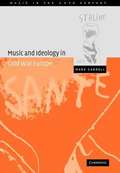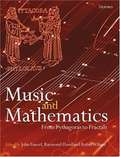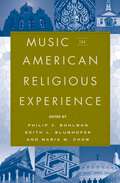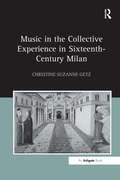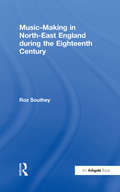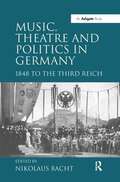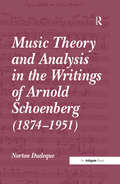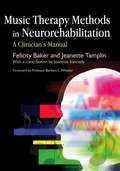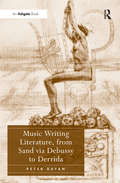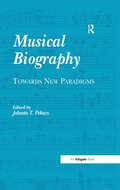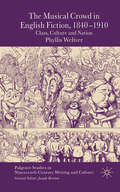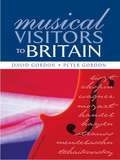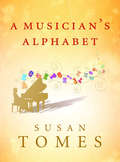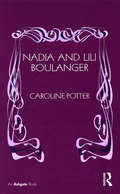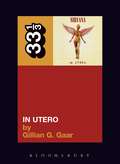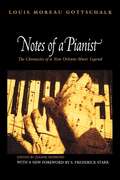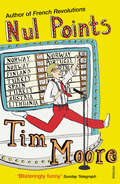- Table View
- List View
Music And Ideology In Cold War Europe (Music In The Twentieth Century Ser. (PDF) #18)
by Mark Carroll Arnold WhittallThis book places the radicalization of art music in early post-war France in its broader socio-cultural and political context. It pursues two general and intersecting lines of inquiry. The first details the stances towards musical conservatism and innovation adopted by cultural strategists representing Western and Soviet ideological interests at the onset of the Cold War. The second, which draws upon the commentaries of Theodor Adorno and Jean-Paul Sartre, recognizes that the Cold War generated a heightened political awareness amongst French musicians at the very time when the social relevance of avant-garde music had become the subject of widespread debate. The study considers the implications of the performance at L'Oeuvre du XXe siècle, an international arts festival staged in Paris in 1952 with the intention of discrediting socialist realism by means of two opposing musical types: neo-classicism (represented by Stravinsky's Symphony in C) and serialism (Boulez's Structures 1a).
Music And Mathematics: From Pythagoras To Fractals (PDF)
by John Fauvel Raymond Flood Robin WilsonFrom Ancient Greek times, music has been seen as a mathematical art, and the relationship between mathematics and music has fascinated generations. This collection of wide ranging, comprehensive and fully-illustrated papers, authorized by leading scholars, presents the link between these two subjects in a lucid manner that is suitable for students of both subjects, as well as the general reader with an interest in music. Physical, theoretical, physiological, acoustic, compositional and analytical relationships between mathematics and music are unfolded and explored with focus on tuning and temperament, the mathematics of sound, bell-ringing and modern compositional techniques.
Music in American Religious Experience
by Philip V. Bohlman Edith L. Blumhofer Maria M. ChowSince the appearance of The Bay Psalm Book in 1640, music has served as a defining factor for American religious experience and has been of fundamental importance in the development of American identity and psyche. The essays in this long-awaited volume explore the diverse ways in which music shapes the distinctive presence of religion in the United States and address the fullness of music's presence in American religious history. Timely, challenging, and stimulating, this collection will appeal to students and scholars of American history, American studies, religious studies, theology, musicology, and ethnomusicology, as well as to practicing sacred musicians.
Music in the Collective Experience in Sixteenth-Century Milan
by Christine Suzanne GetzRenaissance music, like its sister arts, was most often experienced collectively. While it was possible to read Renaissance polyphony silently from a music manuscript or print, improvise alone, or perform as a soloist, the very practical nature of Renaissance music defied individualism. The reading and improvisation of polyphony was most frequently achieved through close co-operation, and this mutual endeavour extended beyond the musicians to include the society to which it is addressed. In sixteenth-century Milan, music, an art traditionally associated with the court and cathedral, came to be appropriated by the old nobility and the new aristocracy alike as a means of demonstrating social primacy and newly acquired wealth. As class mobility assumed greater significance in Milan and the size of the city expanded beyond its Medieval borders, music-making became ever more closely associated with public life. With its novel structures and diverse urban spaces, sixteenth-century Milan offered an unlimited variety of public performance arenas. The city's political and ecclesiastical authorities staged grand processions, church services, entertainments, and entries aimed at the propagation of both church and state. Yet the private citizen utilized such displays as well, creating his own miniature spectacle in a visual and an aural imitation of the ecclesiastical and political panoply of the age. Using archival documents, music prints, manuscripts and contemporary writing, Getz examines the musical culture of sixteenth-century Milan via its life within the city's most influential social institutions to show how fifteenth-century courtly traditions were adapted to the public arena. The book considers the relationship of the primary cappella musicale, including those of the Duomo, the court of Milan, Santa Maria della Scala, and Santa Maria presso San Celso, to the sixteenth-century institutions that housed them. In addition, the book investigates the musician's role as an actor and a functionary in the political, religious, and social spectacles produced by the Milanese church, state, and aristocracy within the city's diverse urban spaces. Furthermore, it establishes a context for the numerous motets, madrigals, and lute intabulations composed and printed in sixteenth-century Milan by examining their function within the urban milieu in which they were first performed. Finally, it musically documents Milan's transformation from a ducal state dominated by provincial traditions into a mercantile centre of international acclaim. Such an important study in Italian Renaissance music will therefore appeal to anyone interested in the culture of Renaissance Italy.
Music in the Collective Experience in Sixteenth-Century Milan
by Christine Suzanne GetzRenaissance music, like its sister arts, was most often experienced collectively. While it was possible to read Renaissance polyphony silently from a music manuscript or print, improvise alone, or perform as a soloist, the very practical nature of Renaissance music defied individualism. The reading and improvisation of polyphony was most frequently achieved through close co-operation, and this mutual endeavour extended beyond the musicians to include the society to which it is addressed. In sixteenth-century Milan, music, an art traditionally associated with the court and cathedral, came to be appropriated by the old nobility and the new aristocracy alike as a means of demonstrating social primacy and newly acquired wealth. As class mobility assumed greater significance in Milan and the size of the city expanded beyond its Medieval borders, music-making became ever more closely associated with public life. With its novel structures and diverse urban spaces, sixteenth-century Milan offered an unlimited variety of public performance arenas. The city's political and ecclesiastical authorities staged grand processions, church services, entertainments, and entries aimed at the propagation of both church and state. Yet the private citizen utilized such displays as well, creating his own miniature spectacle in a visual and an aural imitation of the ecclesiastical and political panoply of the age. Using archival documents, music prints, manuscripts and contemporary writing, Getz examines the musical culture of sixteenth-century Milan via its life within the city's most influential social institutions to show how fifteenth-century courtly traditions were adapted to the public arena. The book considers the relationship of the primary cappella musicale, including those of the Duomo, the court of Milan, Santa Maria della Scala, and Santa Maria presso San Celso, to the sixteenth-century institutions that housed them. In addition, the book investigates the musician's role as an actor and a functionary in the political, religious, and social spectacles produced by the Milanese church, state, and aristocracy within the city's diverse urban spaces. Furthermore, it establishes a context for the numerous motets, madrigals, and lute intabulations composed and printed in sixteenth-century Milan by examining their function within the urban milieu in which they were first performed. Finally, it musically documents Milan's transformation from a ducal state dominated by provincial traditions into a mercantile centre of international acclaim. Such an important study in Italian Renaissance music will therefore appeal to anyone interested in the culture of Renaissance Italy.
Music-Making in North-East England during the Eighteenth Century
by Roz SoutheyThe north-east of England in the eighteenth century was a region where many different kinds of musical activity thrived and where a wide range of documentation survives. Such activities included concert-giving, teaching, tuning and composition, as well as music in the theatre and in church. Dr Roz Southey examines the impulses behind such activities and the meanings that local people found inherent in them. It is evident that music could be perceived or utilized for extremely diverse purposes; as entertainment, as a learned art, as an aid to piety, as a profession, a social facilitator and a support to patriotism and nationalism. Musical societies were established throughout the century, and Southey illustrates the social make-up of the members, as well as the role of Gentlemen Amateurs in the organizing of concerts, and the connections with London and other centres. The book draws upon a rich selection of source material, including local newspapers, council and ecclesiastical records, private papers and diaries and accounts of local tradesman, as well as surviving examples of music composed in the area by Charles Avison, Thomas Ebdon and John Garth of Durham, amongst many others. Charles Avison's importance is focused upon particularly, and his Essay on Musical Expression is considered alongside other contemporary writings of lesser fame. Southey provides a fascinating insight into the type and social class of audiences and their influence on the repertoire performed. The book moves from a consideration of music being used as a 'fashion item', evidenced by the patronage of 'big name' soloists from London and abroad, to fiddlers, ballad singers, music at weddings, funerals, public celebrations, and music for marking the events of the American War of Independence and the French Revolutionary Wars. It can be seen, therefore, that the north east was an area of important musical activity, and that the music was always interwoven into the political, economic, religious and commercial fabric of eighteenth-century life.
Music-Making in North-East England during the Eighteenth Century
by Roz SoutheyThe north-east of England in the eighteenth century was a region where many different kinds of musical activity thrived and where a wide range of documentation survives. Such activities included concert-giving, teaching, tuning and composition, as well as music in the theatre and in church. Dr Roz Southey examines the impulses behind such activities and the meanings that local people found inherent in them. It is evident that music could be perceived or utilized for extremely diverse purposes; as entertainment, as a learned art, as an aid to piety, as a profession, a social facilitator and a support to patriotism and nationalism. Musical societies were established throughout the century, and Southey illustrates the social make-up of the members, as well as the role of Gentlemen Amateurs in the organizing of concerts, and the connections with London and other centres. The book draws upon a rich selection of source material, including local newspapers, council and ecclesiastical records, private papers and diaries and accounts of local tradesman, as well as surviving examples of music composed in the area by Charles Avison, Thomas Ebdon and John Garth of Durham, amongst many others. Charles Avison's importance is focused upon particularly, and his Essay on Musical Expression is considered alongside other contemporary writings of lesser fame. Southey provides a fascinating insight into the type and social class of audiences and their influence on the repertoire performed. The book moves from a consideration of music being used as a 'fashion item', evidenced by the patronage of 'big name' soloists from London and abroad, to fiddlers, ballad singers, music at weddings, funerals, public celebrations, and music for marking the events of the American War of Independence and the French Revolutionary Wars. It can be seen, therefore, that the north east was an area of important musical activity, and that the music was always interwoven into the political, economic, religious and commercial fabric of eighteenth-century life.
Music, Theatre And Politics In Germany: 1848 To The Third Reich
by Nikolaus BachtMusic, theatre and politics have maintained a long-standing, if varying and problematic, relationship. In the Ancient World, the relationship used to be a harmonious one, scholars have us believe, glorifying the moment at the beginning of Western history when a political community, or polis, affirmed itself in a practice that purportedly achieved the perfect integration of music and theatre. To revive this original harmony was, of course, one of the main impulses that engendered the genre of opera. However, while it is widely recognized that the political represented a prius in the Ancient triangle of music, theatre and politics, there has been little attention to the status of the political in the triangle's modern variety. Nonetheless, the relationship between the three continues to be strong. In many contexts, the political still takes priority, encouraging or curbing artistic creativity. The contributions in this volume bridge the conventional chronological division between 'late Romantic' and 'modern' music to thematize a wide array of issues in the context of Germany. The contributors focus on a national tradition and period in which the friction between music, theatre and politics grew particularly intense. Major themes include: reception history; the entwining of aesthetic and political intentions on the part of composers, critics and historians; and the construction and/or critique of collective political identities in and through music theatre.
Music Theory and Analysis in the Writings of Arnold Schoenberg (1874-1951)
by Norton DudequeArnold Schoenberg's theory of music has been much discussed but his approach to music theory needs a new historical and theoretical assessment in order to provide a clearer understanding of his contributions to music theory and analysis. Norton Dudeque's achievement in this book involves the synthesis of Schoenberg's theoretical ideas from the whole of the composer's working life, including material only published well after his death. The book discusses Schoenberg's rejection of his German music theory heritage and past approaches to music-theory pedagogy, the need for looking at musical structures differently and to avoid aesthetic and stylistic issues. Dudeque provides a unique understanding of the systematization of Schoenberg's tonal-harmonic theory, thematic/motivic-development theory and the links with contemporary and past music theories. The book is complemented by a special section that explores the practical application of the theoretical material already discussed. The focus of this section is on Schoenberg's analytical practice, and the author's response to it. Norton Dudeque therefore provides a comprehensive understanding of Schoenberg's thinking on tonal harmony, motive and form that has hitherto not been attempted.
Music Theory and Analysis in the Writings of Arnold Schoenberg (1874-1951)
by Norton DudequeArnold Schoenberg's theory of music has been much discussed but his approach to music theory needs a new historical and theoretical assessment in order to provide a clearer understanding of his contributions to music theory and analysis. Norton Dudeque's achievement in this book involves the synthesis of Schoenberg's theoretical ideas from the whole of the composer's working life, including material only published well after his death. The book discusses Schoenberg's rejection of his German music theory heritage and past approaches to music-theory pedagogy, the need for looking at musical structures differently and to avoid aesthetic and stylistic issues. Dudeque provides a unique understanding of the systematization of Schoenberg's tonal-harmonic theory, thematic/motivic-development theory and the links with contemporary and past music theories. The book is complemented by a special section that explores the practical application of the theoretical material already discussed. The focus of this section is on Schoenberg's analytical practice, and the author's response to it. Norton Dudeque therefore provides a comprehensive understanding of Schoenberg's thinking on tonal harmony, motive and form that has hitherto not been attempted.
Music Therapy Methods in Neurorehabilitation: A Clinician's Manual
by Barbara L Wheeler Felicity Baker Jeanette Kennelly Jeanette TamplinThe value of music therapy in neurological rehabilitation is increasingly recognised and this practical manual provides comprehensive guidance for clinicians on the application of music therapy methods in neurorehabilitation. Felicity Baker and Jeanette Tamplin combine research findings with their own clinical experience and present step-by-step instructions and guidelines on how to implement music therapy techniques for a range of therapeutic needs. Photographs clearly illustrate interventions for physical rehabilitation, for example through the use of musical instruments to encourage targeted movement. The chapter on cognitive rehabilitation includes resources and lists suitable songs for use in immediate memory or abstract thinking tasks, among others. In her chapter on paediatric patients, Jeanette Kennelly demonstrates how procedures can be adapted for working clinically with children. A comprehensive list of terminology commonly used in neurological rehabilitation is also included. Music Therapy Methods in Neurorehabilitation will prove an invaluable reference book for music therapy clinicians and students. It is also suitable for work with other populations, in particular for work in special education.
Music Therapy Methods in Neurorehabilitation: A Clinician's Manual (PDF)
by Barbara L Wheeler Felicity Baker Jeanette Kennelly Jeanette TamplinThe value of music therapy in neurological rehabilitation is increasingly recognised and this practical manual provides comprehensive guidance for clinicians on the application of music therapy methods in neurorehabilitation. Felicity Baker and Jeanette Tamplin combine research findings with their own clinical experience and present step-by-step instructions and guidelines on how to implement music therapy techniques for a range of therapeutic needs. Photographs clearly illustrate interventions for physical rehabilitation, for example through the use of musical instruments to encourage targeted movement. The chapter on cognitive rehabilitation includes resources and lists suitable songs for use in immediate memory or abstract thinking tasks, among others. In her chapter on paediatric patients, Jeanette Kennelly demonstrates how procedures can be adapted for working clinically with children. A comprehensive list of terminology commonly used in neurological rehabilitation is also included. Music Therapy Methods in Neurorehabilitation will prove an invaluable reference book for music therapy clinicians and students. It is also suitable for work with other populations, in particular for work in special education.
Music Writing Literature, from Sand via Debussy to Derrida
by Peter DayanWhy does poetry appeal to music? Can music be said to communicate, as language does? What, between music and poetry, is it possible to translate? These fundamental questions have remained obstinately difficult, despite the recent burgeoning of word and music studies. Peter Dayan contends that the reasons for this difficulty were worked out with extraordinary rigour and consistency in a French literary tradition, echoed by composers such as Berlioz and Debussy, which stretches from Sand to Derrida. Their writing shows how it is both necessary and futile to look for music in poetry, or for poetry in music: necessary, because each art defines itself by reference to what it is not, and cannot be, in order to point to an idealized totality outside itself; futile, because the musicality of poetry, like the poetic meaning of music, must remain as elusive as that idealized totality; its distance is the very condition of the art. Thus is generated a subtle but unmistakable general definition of the nature of art which has proved uniquely able to survive all the probings of poststructuralism. That definition of art is inseparable from a disturbingly effective scepticism towards all forms of explication and explanation in critical discourse, so it is doubtless not surprising that critics in general have done their best to ignore it. But by bringing out what Sand, Baudelaire, Mallarmé, Proust, Debussy, Berlioz, Barthes, and Derrida all do in the same way as they work on the limits of the analogy between music and literature, this book shows how it is possible, productive, illuminating, and fascinating to work on those limits; though to do so, as we find repeatedly, in Chopin's dreams as in Derrida's 'tombeaux', requires us to have the courage to face, in music, our literal death, and the limits of our intelligence.
Music Writing Literature, from Sand via Debussy to Derrida
by Peter DayanWhy does poetry appeal to music? Can music be said to communicate, as language does? What, between music and poetry, is it possible to translate? These fundamental questions have remained obstinately difficult, despite the recent burgeoning of word and music studies. Peter Dayan contends that the reasons for this difficulty were worked out with extraordinary rigour and consistency in a French literary tradition, echoed by composers such as Berlioz and Debussy, which stretches from Sand to Derrida. Their writing shows how it is both necessary and futile to look for music in poetry, or for poetry in music: necessary, because each art defines itself by reference to what it is not, and cannot be, in order to point to an idealized totality outside itself; futile, because the musicality of poetry, like the poetic meaning of music, must remain as elusive as that idealized totality; its distance is the very condition of the art. Thus is generated a subtle but unmistakable general definition of the nature of art which has proved uniquely able to survive all the probings of poststructuralism. That definition of art is inseparable from a disturbingly effective scepticism towards all forms of explication and explanation in critical discourse, so it is doubtless not surprising that critics in general have done their best to ignore it. But by bringing out what Sand, Baudelaire, Mallarmé, Proust, Debussy, Berlioz, Barthes, and Derrida all do in the same way as they work on the limits of the analogy between music and literature, this book shows how it is possible, productive, illuminating, and fascinating to work on those limits; though to do so, as we find repeatedly, in Chopin's dreams as in Derrida's 'tombeaux', requires us to have the courage to face, in music, our literal death, and the limits of our intelligence.
Musical Biography: Towards New Paradigms
by Jolanta T. PekaczMusical biography has rarely been an object of theoretical and methodological reflection. Our present-day perception of the lives of prominent composers and performers of the past has been largely formed by cultural and political assumptions of nineteenth-century biographers and their twentieth-century followers. While older biographies are being scrutinized for veracity and 'updated' with new evidence, their historiographical premisses and narrative techniques remain largely unchallenged. The epistemological upheavals in the humanities since the 1960s have generated a body of theoretical thought that has undermined many of the assumptions of traditional biography. Consequently, many of these assumptions have lost their hold as viable underpinnings for present-day scholarly biography. For example, the accumulation of facts is no longer believed to bring us closer to an understanding of the subject; nor are the traditional views of the unified self and the self as a foundational idea taken for granted. This volume brings together musicologists and historians who explore, through individual case studies, the rich potential of these new theories for writing musical lives. The authors of this volume examine how the insights provided by these theories illuminate our critical reassessment of older biographies - and the interpretations of musical works these biographies were used to construe - and help forge new approaches to musical biography. The authors also explore the functions musical biographies served in different historical contexts, the relevance of biography for musical criticism, the reliability of archival evidence, the ethics of biography, the demands placed on biography by feminist and gender history, and the new possibilities offered by cinema. The contributors to this volume challenge the view that biography has little importance for music history, analysis, and criticism. Collectively, they reassert biography's centrality and relevance, and dem
Musical Biography: Towards New Paradigms
by Jolanta T. PekaczMusical biography has rarely been an object of theoretical and methodological reflection. Our present-day perception of the lives of prominent composers and performers of the past has been largely formed by cultural and political assumptions of nineteenth-century biographers and their twentieth-century followers. While older biographies are being scrutinized for veracity and 'updated' with new evidence, their historiographical premisses and narrative techniques remain largely unchallenged. The epistemological upheavals in the humanities since the 1960s have generated a body of theoretical thought that has undermined many of the assumptions of traditional biography. Consequently, many of these assumptions have lost their hold as viable underpinnings for present-day scholarly biography. For example, the accumulation of facts is no longer believed to bring us closer to an understanding of the subject; nor are the traditional views of the unified self and the self as a foundational idea taken for granted. This volume brings together musicologists and historians who explore, through individual case studies, the rich potential of these new theories for writing musical lives. The authors of this volume examine how the insights provided by these theories illuminate our critical reassessment of older biographies - and the interpretations of musical works these biographies were used to construe - and help forge new approaches to musical biography. The authors also explore the functions musical biographies served in different historical contexts, the relevance of biography for musical criticism, the reliability of archival evidence, the ethics of biography, the demands placed on biography by feminist and gender history, and the new possibilities offered by cinema. The contributors to this volume challenge the view that biography has little importance for music history, analysis, and criticism. Collectively, they reassert biography's centrality and relevance, and dem
The Musical Crowd in English Fiction, 1840-1910: Class, Culture and Nation (Palgrave Studies in Nineteenth-Century Writing and Culture)
by P. WeliverThis book provides insight into how musical performances contributed to emerging ideas about class and national identity. Offering a fresh reading of bestselling fictional works, drawing upon crowd theory, climate theory, ethnology, science, music reviews and books by musicians to demonstrate how these discourses were mutually constitutive.
Musical Visitors to Britain (Woburn Education Series)
by Peter GordonBritain has attracted many musical visitors to its shores. A varied and often eccentric collection of individuals, some were invited by royalty with musical tastes, some were refugees from religious or political oppression, some were spies, and others came to escape debt or even charges of murder. This book paints a broad picture of the changing nature of musical life in Britain over the centuries, through the eyes and ears of foreign musicians. After considering three of the eighteenth century’s greatest musical figures, the authors consider the rise of the celebrity composer in the nineteenth century, and go on to consider the influence of new forms of transport which allowed travel more freely from the Continent and the USA. Musical Visitors to Britain also charts the new opportunities presented by the opening of public halls, the growth of music festivals, and the regular influx of composers in the twentieth and twenty-first centuries, ending with the impact of new musical forms such as jazz. As much a social as a musical history of Britain, this book will be of interest to anyone studying or working in these fields, as well as to general readers who want to discover more about our musical heritage.
Musical Visitors to Britain (Woburn Education Series)
by Peter GordonBritain has attracted many musical visitors to its shores. A varied and often eccentric collection of individuals, some were invited by royalty with musical tastes, some were refugees from religious or political oppression, some were spies, and others came to escape debt or even charges of murder. This book paints a broad picture of the changing nature of musical life in Britain over the centuries, through the eyes and ears of foreign musicians. After considering three of the eighteenth century’s greatest musical figures, the authors consider the rise of the celebrity composer in the nineteenth century, and go on to consider the influence of new forms of transport which allowed travel more freely from the Continent and the USA. Musical Visitors to Britain also charts the new opportunities presented by the opening of public halls, the growth of music festivals, and the regular influx of composers in the twentieth and twenty-first centuries, ending with the impact of new musical forms such as jazz. As much a social as a musical history of Britain, this book will be of interest to anyone studying or working in these fields, as well as to general readers who want to discover more about our musical heritage.
A Musician's Alphabet
by Susan TomesHave you ever wondered whether musicians notice the audience or are influenced by them? Wanted to know how performers might learn particularly difficult pieces? Thought about the terms 'old' and 'young' in reference to music?Using the letters of the alphabet as her starting point, Susan Tomes presents a series of lively reflections on performing music, and on the classical music world. Drawing on her international experience as a solo pianist and chamber musician, she offers intriguing insights into rehearsal and practice, coping with nerves, and on the relationship between musicians and their audience. The book also contains thought-provoking meditations on the role of classical music in society, and the most rewarding attitudes to performance. This pocket-sized musical 'A to Z' is an invaluable guide and is a must for anyone interested in what makes musicians tick.
Nadia and Lili Boulanger
by Caroline PotterPioneers in their fields and two of the best-known women in music in the twentieth century, Nadia and Lili Boulanger have previously been considered in isolation from one another. Yet, as Caroline Potter's new book demonstrates, their careers were closely linked during Lili Boulanger's short life (1893-1918) and there are several intriguing connections between their musical works. This biography also provides the first full analysis of the Boulanger sisters' musical styles, placing them within the context of French musical history. Their lives are also a case study in the issues of gender which surround music making even to the present day. Despite an unusually privileged upbringing, Nadia and Lili Boulanger exemplify the struggle women experienced when attempting to enter the professional music world. Lili became the first woman to win the Prix de Rome in 1913, and Nadia gained second place in 1908. Yet in spite of this initial success, Nadia Boulanger was to give up composing in her thirties and devoted the remainder of her long life to teaching. Her pupils included several of the great composers of the century, including Aaron Copland and Elliott Carter. This book, focusing on their musical careers, is essential reading for anyone interested in French music of the twentieth century.
Nadia and Lili Boulanger
by Caroline PotterPioneers in their fields and two of the best-known women in music in the twentieth century, Nadia and Lili Boulanger have previously been considered in isolation from one another. Yet, as Caroline Potter's new book demonstrates, their careers were closely linked during Lili Boulanger's short life (1893-1918) and there are several intriguing connections between their musical works. This biography also provides the first full analysis of the Boulanger sisters' musical styles, placing them within the context of French musical history. Their lives are also a case study in the issues of gender which surround music making even to the present day. Despite an unusually privileged upbringing, Nadia and Lili Boulanger exemplify the struggle women experienced when attempting to enter the professional music world. Lili became the first woman to win the Prix de Rome in 1913, and Nadia gained second place in 1908. Yet in spite of this initial success, Nadia Boulanger was to give up composing in her thirties and devoted the remainder of her long life to teaching. Her pupils included several of the great composers of the century, including Aaron Copland and Elliott Carter. This book, focusing on their musical careers, is essential reading for anyone interested in French music of the twentieth century.
Nirvana's In Utero (33 1/3)
by Gillian G. GaarThough Nevermind was Nirvana's most commercially successful album, and the record that broke them - and the grunge phenomenon - internationally, In Utero has increasingly become regarded as the band's best album, both by the critics and the band members themselves. Instead of sticking to the "grunge pop" formula that made Nevermind so palatable to the mainstream, Nirvana chose instead to challenge their audience, producing an album that the band's creative force, Kurt Cobain, said truly matched his vision of what he had always wanted his band to sound like. Here, the full story behind the creation of In Utero is told for the first time.
Notes of a Pianist
by Louis Moreau Gottschalk Jeanne Behrend Frederick S. StarrNotes of a Pianist chronicles the life of one of the most remarkable musical minds of the American experience, the great nineteenth-century New Orleans-born composer and pianist Louis Moreau Gottschalk (1829-1869). An important cultural and historical work, the book recounts Gottschalk's experiences as he traveled and performed throughout the last decade of his life. Born to an English-Jewish father and a Haitian mother, Gottschalk is remembered as one of the great New Orleans musicians and composers, his music a combination of the classical tradition in which he was trained, and the New Orleans tradition into which he was born. His art form took him far outside the boundaries of Louisiana, however. While still a child, he studied piano in Paris and gave a concert at the Salle Pleyel, after which Frédéric Chopin is said to have remarked: "Give me your hand, my child; I predict that you will become the king of pianists." Gottschalk returned to the United States in 1853, and later lived in Cuba, Puerto Rico, Panama, and South America, during which time he kept-sometimes sporadically, sometimes daily--the notebooks that formed the basis of Notes of a Pianist. Published for the first time in 1881, the book continues to resonate with American cultural and musical life. Notes of a Pianist demonstrates Gottschalk's importance not only as a reporter of the musical life and tastes of Americans during the Civil War, but also as a forefather of Louisiana's rich musical culture.
Nul Points
by Tim MooreThe spangled insanity, the stubborn reinforcement of crude national stereotypes, the scoreboard shamelessly corrupted by cross-border friendship and hatred... throughout those long post-ABBA decades, the Eurovision Song Contest has been drawing 450 million of us to the sofa for all the wrong reasons. And the most gloriously wrong of all: our enduring fascination with the unfortunates left to wander the desolate summit of Mount Fiasco without a point to their names.From Lisbon to Liverpool, from the Black Sea to the Baltic, Tim Moore travels the continent to track down the thirteen Eurominstrels who suffered the entertainment world's prime humiliation.
